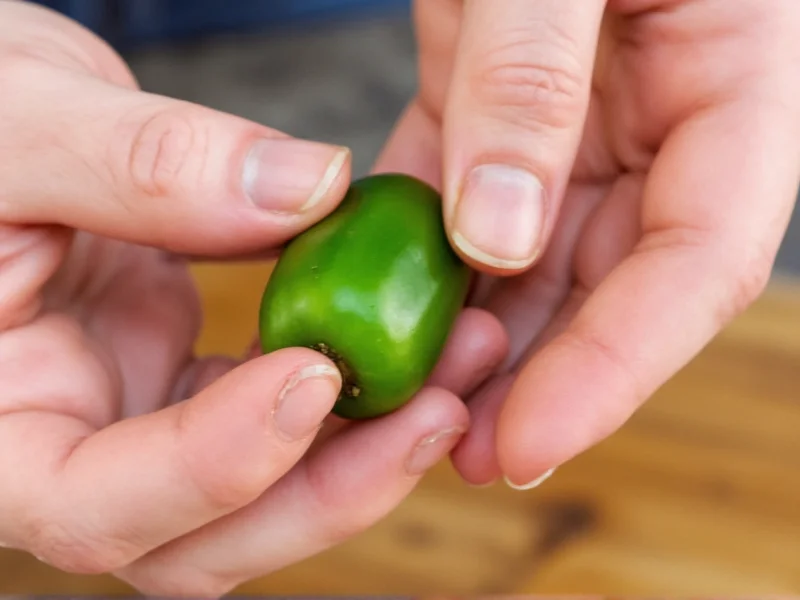If you've ever chopped jalapeños without gloves, you know that painful burning sensation that lingers on your skin for hours. This discomfort happens because jalapeños contain capsaicin, an oil-based compound that triggers pain receptors in your skin. Unlike water-soluble substances, capsaicin doesn't wash away with plain water alone. Understanding how to properly remove jalapeño from hands requires knowing how to break down this stubborn oil.
Why Jalapeños Cause Burning Sensation
Capsaicin, the chemical responsible for chili heat, binds to TRPV1 receptors in your skin that normally detect heat and pain. This triggers a burning sensation that can last for hours. Since capsaicin is oil-soluble rather than water-soluble, regular hand washing often fails to provide complete relief. The key to effective removal lies in using substances that can dissolve or neutralize this compound.
Most Effective Methods to Remove Jalapeño Residue
Not all remedies work equally well for eliminating jalapeño burn from hands. Below we've ranked solutions by effectiveness based on capsaicin's chemical properties:
| Method | Effectiveness | Time Required | Notes |
|---|---|---|---|
| Dairy products (milk, yogurt) | ★★★★★ | 5-10 minutes | Casesin in dairy binds to capsaicin |
| Oil-based solutions | ★★★★☆ | 3-5 minutes | Olive oil, vegetable oil, or cooking spray |
| Alcohol-based cleaners | ★★★☆☆ | 2-3 minutes | Hand sanitizer or rubbing alcohol |
| Baking soda paste | ★★★☆☆ | 5-10 minutes | Mix with water to form paste |
| Soap and cold water | ★★☆☆☆ | 3-5 minutes | Must use immediately after handling |
Detailed Step-by-Step Removal Techniques
1. Dairy-Based Solutions (Most Effective)
Soak your hands in cold milk or apply plain yogurt directly to affected areas. The casein protein in dairy products binds to capsaicin molecules and helps wash them away. Submerge your hands for 5-10 minutes while gently rubbing the affected areas. This method works because casein acts as a detergent for the oily capsaicin compound. Many home cooks report complete relief within minutes using this approach for how to get rid of jalapeno burn on hands.
2. Oil-Based Removal Method
Apply olive oil, vegetable oil, or even cooking spray to your hands. Massage the oil into your skin for 2-3 minutes, then wash thoroughly with soap and cold water. The oil dissolves the capsaicin through "like dissolves like" chemistry. This technique provides quick relief for how to stop jalapeno hands from burning when dairy isn't available. Remember to use cold water during the final wash to prevent opening pores further.
3. Alcohol-Based Cleaners
Apply hand sanitizer or rubbing alcohol to your hands and rub thoroughly for 2-3 minutes before washing with soap and cold water. Alcohol breaks down the capsaicin molecules effectively. This method works well as an immediate remedy for jalapeno hands treatment that actually works when you're away from home. Keep a travel-size hand sanitizer in your kitchen for emergencies.
4. Baking Soda Paste
Mix baking soda with a small amount of water to create a thick paste. Apply to affected areas and gently rub for 3-5 minutes before rinsing with cold water. The mild abrasiveness helps remove capsaicin while the alkaline nature neutralizes the compound. This solution proves effective for how to remove jalapeno oil from skin when other options aren't available.
Critical Mistakes to Avoid
Many people worsen the burning sensation by making these common errors:
- Using hot water - Opens pores and drives capsaicin deeper into skin
- Rubbing eyes or face - Transfers capsaicin to sensitive areas
- Waiting too long to treat - Capsaicin bonds more strongly over time
- Using only soap and water - Often insufficient for complete removal
Prevention Tips for Future Handling
The best approach for how to prevent jalapeno burn when cutting involves preparation:
- Wear disposable nitrile gloves (latex doesn't protect well against oils)
- Apply a thin layer of cooking oil to hands before handling peppers
- Use a dedicated cutting board for spicy peppers
- Wash knives and cutting surfaces with soapy water immediately after use
- Keep dairy products nearby when working with hot peppers
When to Seek Medical Attention
While jalapeño burns typically resolve with home treatment, consult a healthcare provider if you experience:
- Severe blistering or skin damage
- Persistent burning lasting more than 24 hours
- Signs of infection (increased redness, swelling, pus)
- Accidental contact with eyes or other sensitive membranes
Understanding Capsaicin Chemistry for Better Results
The effectiveness of different removal methods depends on capsaicin's chemical properties. As a hydrophobic (water-repelling) compound, capsaicin requires lipid solvents or specific binding agents for complete removal. This explains why dairy (casein), oils (lipid solvents), and alcohol (organic solvent) work better than plain water. Understanding this chemistry helps you adapt solutions when standard remedies aren't available, providing reliable jalapeno hands treatment that actually works in various situations.











 浙公网安备
33010002000092号
浙公网安备
33010002000092号 浙B2-20120091-4
浙B2-20120091-4